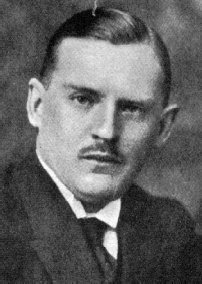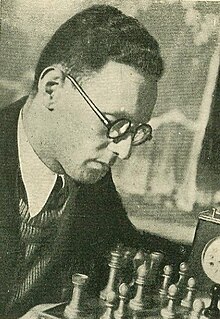Interregnum (chess)
As interregnum ( lat. "Interim Government") is in chess , the period between the death of the reigning world chess champion Alexander Alekhine on March 24, 1946 and the completion of one of Mikhail Botvinnik won the tournament on May 17, 1948 called, in which there was no world chess champion.
The Interregnum coincided with the reorganization of FIDE after the Second World War . According to FIDE President Alexander Rueb, FIDE wanted to meet in Zurich in the summer of 1946 to discuss the continuation of international chess and a possible world championship match between Alekhine and Botvinnik, which would have been the first world championship match since the 1937 World Chess Championship . However, Alekhine died on March 24, 1946 in Portugal. In the meantime to WinterthurAfter the postponed meeting, FIDE showed a sign of life for the first time since 1938. Financially shaken by the Second World War, member states had initially stopped paying annual dues and were still having problems raising money for the meeting. Ultimately, only nine states were able to participate, which is why resolutions were only valid until the next congress one year later. Other states did not have a recognized national federation.
At the congress, a four-round world championship tournament between five named and one unnamed player in the Netherlands was decided in July 1947. Two qualifying tournaments in Groningen and Prague should determine the further candidate. Further world championships were to take place in 1950 and 1953.
Most recently - following a complaint from the United States regarding the time of qualification - Michail Botwinnik, Paul Keres , Wassili Smyslow (both Soviet Union), Samuel Reshevsky and Isaac Kashdan (both United States) were nominated and Miguel Najdorf (Argentina) by winning the qualifying tournament in Prague set as a participant. The United States picked the top two finishers in the US Championship. Since Reuben Fine , who was first proposed by FIDE, did not have time to compete in the US championship, he was replaced by Isaac Kashdan.
The world championship finally collapsed due to political disagreements.
In 1947, Botvinnik wrote that FIDE, in its current state, was unable to host a world championship. Because she has neither the necessary authority nor the financial means. In his opinion, a world championship tournament should be held and the reigning world champion should compete every few years against the winner of a qualifying tournament in a one-on-one, whereby the title would become vacant again if a one-on-one did not take place.
In the meantime, Keres, Botvinnik, Smyslov, Fine and Reshevsky were again being discussed as World Cup candidates when Miguel Najdorf announced that he would play no worse than the five candidates.
From July 30th to August 2nd, 1947, the annual FIDE meeting took place in The Hague. It was decided that the world championship match would take place in March 1948, with a two-week break during the tournament. Botvinnik, Smyslow, Keres, Fine, Reshevsky and Euwe were planned as participants.
In early 1948, Fine canceled his participation in the tournament because he was working on his dissertation in psychology. Efforts to get Fine to participate failed.
The 1948 World Chess Championship finally took place from March 1, 1948 as a tournament in which a total of 20 rounds were played in The Hague and Moscow, with Botvinnik being determined as the world champion.
Ladies
With the world chess champions there was also a period of several years without a title holder after Vera Menchik fell victim to a rocket attack by the Germans on Kent in World War II on June 27, 1944, where she was killed together with her mother and sister Olga Rubery . The title remained vacant until 1950, when Lyudmila Rudenko won the round- robin tournament for the women's chess world championship in 1949/50 . After that, the world champion was determined in duels until 1996, with the challengers having to qualify in world championship cycles.
Web links
- Edward Winter : Interregnum. In: chesshistory.com. April 2003 (English).
Individual evidence
- ↑ V1 & V2 logs SW4 and 9 Brixton and Clapham . Retrieved August 26, 2014.

